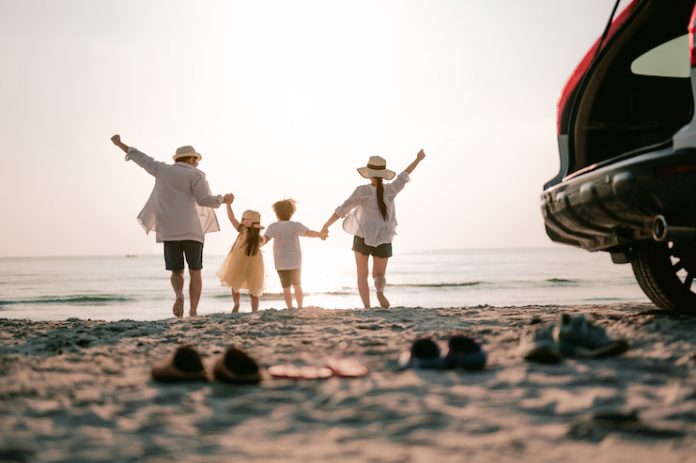
Safety perceptions related to travel and social activities are at their highest point since the pandemic began, prompting many U.S. travelers to plan summer trips. However, amid renewed optimism for leisure travel, financial concerns and higher prices weigh on travelers. Deloitte’s new report, “Getting Back to Getaways: 2022 Deloitte Summer Travel Survey,” examines the trends and preferences that will guide leisure trips this season. The report is based on a survey of 4,233 U.S. adults fielded between March 23-30, 2022. Among those, 2,536 qualified as travelers, and a smaller subset of 1,960 travelers said they would stay in paid lodging rather than only with family or friends.
Key takeaways include:
- Travel intent takes off as 6 in 10 U.S. adults plan to travel this summer, up from 5 in 10 last year.
- Overall travel spend will increase. Among travelers, 28 percent plan to spend more than in 2019, up 6 percent compared to 2021, even as consumers grow weary of higher airfares and lodging rates.
- COVID-related concerns continue to influence travel decisions, although financial concerns are now the top reason among U.S. adults planning to stay home.
- Although international travel has become significantly more convenient over the past year, only 1 in 8 U.S. adults plan to go abroad this summer as COVID-19 requirements remain unpredictable.
- Private rental adoption continues to grow. Among the 20 percent of travelers planning to stay in private rentals, 1 in 7 will use this lodging type for the first time this summer.
- Spurred by flexible work arrangements, 1 in 5 travelers plan to work during their longest summer trip. “Laptop luggers” plan to take more trips and spend more and exhibit distinctive preferences across travel decisions.
While leisure travel appeared to be on the rebound last summer, the Delta and Omicron COVID variants slowed its comeback. Now, with traveler confidence on the rise, summer 2022 travel will likely surpass both 2021 and pre-pandemic levels, with a desire to spend time with family and friends the main driver for travel. However, financial and health concerns will continue to impact where and how Americans travel.
- Six in 10 U.S. adults will travel this summer, an increase from last year when 5 in 10 planned the same.
- Travelers will take an average of two trips this summer with most (83 percent) planning to stay in hotels and/or rentals. Half (51 percent) plan to fly, while slightly more plan to take road trips (57 percent). Only 7 percent plan to take a cruise.
- More than one-quarter (28 percent) of travelers plan to spend significantly more this summer over their 2019 travel budgets for marquee trips, due to higher prices as well as accumulated savings. Meanwhile, 15 percent plan to spend significantly less; half of those travelers cite financial concerns.
- Spending time with family and friends is the top motivator for summer travel at 47 percent, up 13 percent from 2021.
- Beaches continue to lead all destinations (32 percent), followed by cities (29 percent) and the great outdoors (16 percent).
- About two-thirds of travelers (65 percent) are planning their longest trips for June and July, but roads and skies should be busy all summer with 45 percent of all trips slated for August or September. Further, trip durations will shrink compared to 2021; for one-third of travelers (32 percent), the longest trip will last less than one week, up from 22 percent in 2021.
Travelers have a variety of options for their summer trips. As trust in the safety of lodging and air travel rises, they are willing to pay for comfort and space, signaling further optimism for travel providers.
- Nearly half (46 percent) of U.S. adults will travel and stay in paid lodging, up from 41 percent in 2021.
- While hotels remain more popular (79 percent), private rental demand is strong (20 percent). More than one-third (34 percent) of summer rental travelers booked a private rental or plan to for the first time, up from 28 percent in 2021. Further, 7 in 10 of these new rental guests expect to continue staying in rentals for at least half of their trips going forward.
- Younger travelers (18-34 years old) are almost twice as likely to stay in private lodging (26 percent) as travelers 55 and older (14 percent).
Safety perceptions for air travel are at their highest since the pandemic began. More than half (54 percent) of U.S. travelers feel safe taking a flight this summer, compared to 31 percent in 2021.
- Nearly half (47 percent) of travelers will fly for their marquee trip, and 54 percent are willing to pay for a more comfortable flight experience including first or business class (17 percent) or other upgrades (37 percent).
- One-quarter (27 percent) of air travelers will fly overseas, with Europe being the most popular destination (49 percent); followed by Mexico and the Caribbean (28 percent); Asia (8 percent); Central/South America (7 percent); EMEA (6 percent); and Australia/Oceania (2 percent). Among international travelers age 55 and older, 6 in 10 plan to visit Europe, versus 4 in 10 younger travelers. Geopolitical developments factor into travel decisions for 6 in 10 travelers.
- With the rise in air travel, fewer U.S. travelers will hit the road this summer: 62 percent will drive for at least one part of their trip, down from 76 percent in 2021. Nearly half (48 percent) are driving shorter distances (four hours or less), up from 33 percent in 2021. Further, 8 in 10 of these trips will last for a week or less, which could contribute to the rise in shorter-distance road trips.
“This summer, Americans are more ready to travel than they have been since the pandemic began. As they take to the roads and skies, this pent-up demand is driving spending across a variety of travel products. Air travel is set to soar, and demand for both hotels and private rentals is strong. While COVID-19 transmission and financial concerns still factor into travel decisions, travel providers who remain flexible to consumers’ shifting preferences will find new opportunities for their businesses to take off and thrive,” Eileen Crowley, vice chair, Deloitte & Touche LLP and U.S. transportation, hospitality, and services attest leader.
COVID-19 transmission remains an important factor in travel decisions, although its influence is waning. However, financial concerns are high with nearly half of those not traveling citing money as the reason why they will stay home.
- This summer, finances (44 percent, up 13 percent from 2021) replace health as travelers’ main concern (33 percent, down 10 percent from 2021).
- Travelers with a household income under $50,000 are twice as likely to say they significantly cut travel budgets from 2019, compared to those at higher income levels.
- Although still a consideration, health factors that play a role in destination selection are all down in influence compared to last year, including crowd avoidance (68 percent, down 7 percent), CDC guidelines (65 percent, down 9 percent), and social distancing norms (61 percent, down 13 percent).
Travelers this year are more likely to participate in activities involving sharing space with others, such as dining (up 6 percent) and visiting attractions (up 2 percent).
Work-from-home and location-flexible work arrangements are contributing to a new type of leisure traveler—“laptop luggers.” Those who plan to work at least partially when they travel this summer attribute at least one trip to the ability to work remotely. Further, laptop luggers tend to spend more, take longer trips, and travel with larger groups.
- One in 5 travelers are “laptop luggers” who plan to bring some work along on their vacation, spurring more frequent and longer trips.
- Among laptop luggers, 3 in 4 say their longest trip will last one to three weeks. In addition, 4 in 5 are extending their trip due to the ability to work remotely, with one-third extending their trip by three to six days.
- The majority of laptop luggers are younger and wealthier: 18-to-34-year-olds are five times more likely to work on vacation, and those reporting income of more than $100,000 per year are twice as likely to do so. Four in 10 laptop luggers say their trip budget exceeds pre-pandemic levels, compared to 25 percent of disconnectors.
- Laptop luggers will travel in larger groups: 3 in 10 will travel with three to five people, often including children.
- Laptop luggers, who are twice as likely to stay at private rentals for the first time during the pandemic, are nearly 1.5 times as likely to continue using them in half or more future trips.
- Overall, the remote work experience surged as a factor in lodging choice. For hotels, the remote working experience increased 12 percent in influence from 2021, while the space to work inherent in private rentals increased 19 percent in influence since last year.
“With traveler confidence increasing and health concerns declining, Americans are packing their bags and upgrading their summer trips. However, a rise in financial concerns for some will keep them grounded. At the same time, flexible work arrangements are creating a whole new world of opportunities for travel suppliers to build loyalty among laptop luggers. These travelers are willing to take a meeting and a stroll on the beach during the same trip—and extend their time away in the process,” Mike Daher, vice chair, Deloitte LLP and U.S. transportation, hospitality, and services non-attest leader









More Stories
Minor rebrands Thai site to become first Asian NH Hotel
members only – exclusivity or community? • Hotel Designs
Get in on the Gift Voucher Game